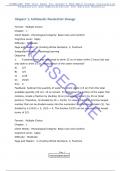DOWNLOAD THE Test Bank for Henke's Med-Math Dosage Calculation
Preparation and Administration 9th Edition Buchholz
Chapter 1, Arithmetic Needed for Dosage
Format: Multiple Choice
Chapter: 1
Client Needs: Physiological Integrity: Basic Care and Comfort
Cognitive Level: Apply
Difficulty: Moderate
Page and Header: 2, Dividing Whole Numbers; 3, Fractions
N
Integrated Process: Teaching/Learning
Objective: 1, 2
U
1. A patient/client was instructed to drink 25 oz of water within 2 hours but was
only able to drink 15 oz. What portion of the water remained?
R
A) 2/5
B) 3/5
SE
C) 2/25
D) 25/25
Ans: A
Feedback: Subtract the quantity of water the client drank (15 oz) from the total
C
available quantity (25 oz): 10 oz remain. To determine the portion of the water that
remains, create a fraction by dividing 10 oz (remaining portion) by 25 oz (total
AR
portion). Therefore, 10 divided by 25 = 10/25. To reduce fractions, find the largest
number that can be divided evenly into the numerator and the denominator (5). Ten
divided by 5 (10/5) = 2; 25/5 = 5. The fraction 10/25 can be reduced to its lowest
terms of 2/5.
E
Format: Multiple Choice
Chapter: 1
Client Needs: Physiological Integrity: Basic Care and Comfort
Cognitive Level: Apply
Difficulty: Moderate
Page and Header: 2, Dividing Whole Numbers; 3, Fractions
Page 1
mynursytest.store
,DOWNLOAD THE Test Bank for Henke's Med-Math Dosage Calculation
Preparation and Administration 9th Edition Buchholz
Integrated Process: Teaching/Learning
Objective: 1, 2
2. A patient/client was prescribed 240 mL of Ensure by mouth as a supplement
but consumed only 100 mL. What portion of the Ensure remained?
A) 5/12
B) 7/12
C) 100/240
D) 240/240
Ans: B
N
Feedback: Subtract the quantity of Ensure the client consumed (100 mL) from the
total available quantity (240 mL): 140 mL remain. To determine the portion of the
U
Ensure that remains, create a fraction by dividing 140 mL (remaining portion) by 240
mL (total portion). Therefore, 140 divided by 240 = 7/12. To reduce fractions, find the
R
largest number that can be divided evenly into the numerator and the denominator
(20); 140 divided by 20 (140/20) = 7; 240/20 = 12. The fraction 140/240 can be
SE
reduced to its lowest terms of 7/12.
Format: Multiple Choice
Chapter: 1
C
Client Needs: Physiological Integrity: Basic Care and Comfort
Cognitive Level: Analyze
AR
Difficulty: Difficult
Page and Header: 2, Multiplying Whole Numbers; 3, Fractions
Integrated Process: Communication and Documentation
Objective: 1, 2
E
1 1
3. A patient/client consumed 2 4 oz. of coffee, 2/3 oz. of ice cream, and 1 2 oz.
of beef broth. What is the total number of ounces consumed that should be
documented for the patient/client?
A) 3 3/4
B) 4 5/12
C) 4 2/3
D) 4 4/9
Page 2
mynursytest.store
, DOWNLOAD THE Test Bank for Henke's Med-Math Dosage Calculation
Preparation and Administration 9th Edition Buchholz
Ans: B
Feedback: Add the amount of ounces consumed. First, change any mixed number to
a fraction by multiplying the whole number by the denominator and then adding that
total to the numerator. For the coffee, 4 2 = 8 + 1 = 9/4; for the beef broth, 2 1
= 2 + 1 = 3/2. Then add: 9/4 + 2/3 (ice cream) + 3/2. When fractions have different
denominators, find the least common denominator (LCD). For 2, 3, and 4, the LCD =
12. Rewrite each fraction using the LCD; divide the LCD by the denominator of each
fraction and then multiply that result by the numerator of the fraction. The new
fractions to be added are 27/12 (coffee), 8/12 (ice cream), and 18/12 (beef broth).
N
After conversion of the fractions, the numerators are added together and the fraction
is reduced to the lowest terms.
U
Format: Multiple Choice
R
Chapter: 1
Client Needs: Physiological Integrity: Basic Care and Comfort
SE
Cognitive Level: Analyze
Difficulty: Difficult
Page and Header: 2, Multiplying Whole Numbers; 3, Fractions
Integrated Process: Communication and Documentation
C
Objective: 1, 2
4. A coffee cup holds 180 mL. The patient/client drank 2⅓ cups of coffee. How
AR
many milliliters would the nurse document as consumed?
A) 360
B) 420
C) 510
E
D) 600
Ans: B
Feedback: The coffee cup holds 180 mL. The client drank 2⅓ cups. To estimate the
total number of milliliters consumed, multiply 180 7/3 (2⅓). When a mixed number
is present, change it to an improper fraction by multiplying the whole number by the
denominator and then adding that total to the numerator: 2 3 = 6 + 1 = 7/3.
Therefore, 180 mL × 7/3 = 420 mL (180 ÷ 3 = 60 × 7 = 420).
Page 3
mynursytest.store




